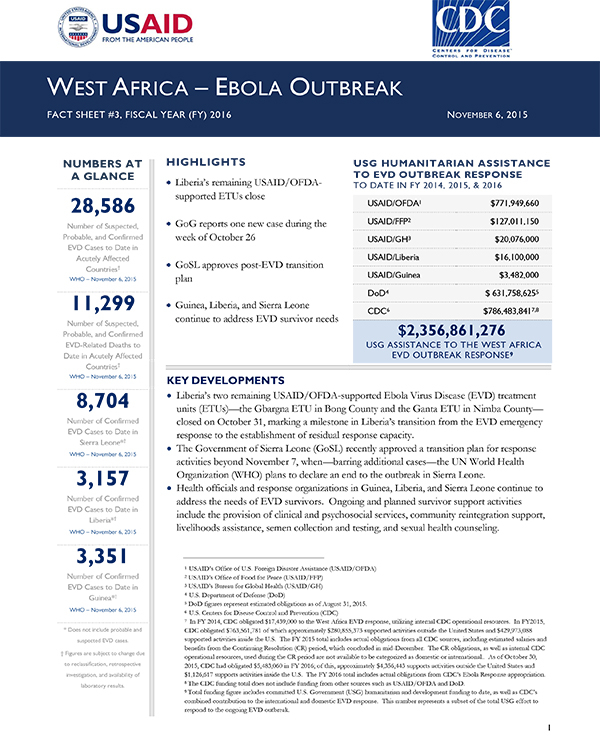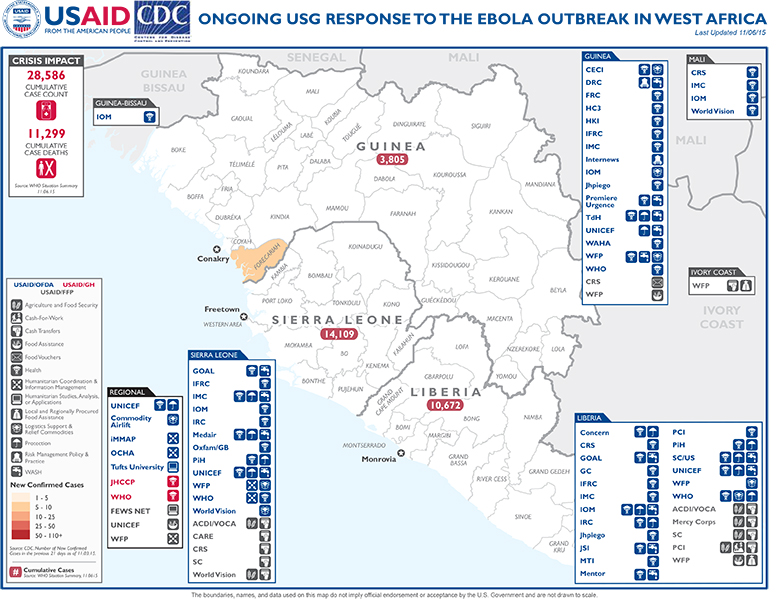November 6, 2015
HIGHLIGHTS
Ebola Response
Visit our main West Africa Ebola Outbreak page to learn more about how we're responding to the West Africa Ebola outbreak, and what you can do to help.
- Liberia's remaining USAID/OFDA-supported ETUs close
- GoG reports one new case during the week of October 26
- GoSL approves post-EVD transition plan
- Guinea, Liberia, and Sierra Leone continue to address EVD survivor need
KEY DEVELOPMENTS
- Liberia/s two remaining USAID/OFDA-supported Ebola Virus Disease (EVD) treatment units (ETUs)—the Gbargna ETU in Bong County and the Ganta ETU in Nimba County— closed on October 31, marking a milestone in Liberia’s transition from the EVD emergency response to the establishment of residual response capacity.
- The Government of Sierra Leone (GoSL) recently approved a transition plan for response activities beyond November 7, when—barring additional cases—the UN World Health Organization (WHO) plans to declare an end to the outbreak in Sierra Leone.
- Health officials and response organizations in Guinea, Liberia, and Sierra Leone continue to address the needs of EVD survivors. Ongoing and planned survivor support activities include the provision of clinical and psychosocial services, community reintegration support, livelihoods assistance, semen collection and testing, and sexual health counseling.
Liberia
Marking a key step in Liberia’s transition from the EVD emergency response to the establishment of residual response capacity, the country’s two remaining USAID/OFDA-supported ETUs—the International Medical Corps (IMC)- managed Gbargna ETU and the Project Concern International (PCI)-managed Ganta ETU—closed on October 31. Over the course of the EVD outbreak, USAID/OFDA supported 20 ETUs in Liberia. The Government of Liberia (GoL) Ministry of Health (MoH)-managed ELWA III ETU in Liberia’s capital city of Monrovia is now the country’s sole operational unit. As part of the GoL strategy for maintaining residual EVD treatment capacity in regional referral centers, USAID/OFDA partners are finalizing temporary isolation and treatment sites at GoL-designated hospitals and clinics.
USAID/OFDA partner Global Communities (GC) continues to deactivate burial teams in concert with a GoL policy shift from universal safe and dignified burials (SDBs) to universal dead body swabbing. As of October 25, GC had demobilized burial teams in eight of Liberia’s 15 counties, with plans to demobilize teams in the seven remaining counties in the coming weeks. To ensure an effective transition from the GC burial teams to county-level actors, GC continues to train clinicians, environmental health technicians (EHTs), and funeral home staff in proper dead body swabbing procedures, while working with community-level leadership to ensure compliance with the new GoL policy.
Despite significant progress, the USG Disaster Assistance Response Team (DART) reports several challenges related to the transition from SDBs to post-mortem swab collection. The GoL has issued several iterations of the national dead body management policy; however, changes to the policy are not always well understood by the broader community, including those responsible for dead body swabbing. The former GoL policy of conducting a polymerase chain reaction test for all community deaths—a procedure that takes up to four days—contributed to the underreporting of such deaths. Per the current policy, the GoL requires trained EHTs or staff from funeral homes and health care facilities to don proper personal protective equipment and conduct post-mortem swabs of all dead bodies; only those considered highrisk require an SDB.
On October 31, the DART attended a launch ceremony for Mercy Corps’ Ebola Community Action Platform 2 (ECAP 2), which targets 1,500 community health committees countrywide—including in five MoH-identified priority counties— to promote EVD-related social mobilization messages. Through local organizations, ECAP 2 will conduct tailored outreach campaigns to increase community knowledge about the importance of surveillance, including details pertaining to the revised GoL dead body swabbing policy; promote health practices to prevent the transmission of communicable diseases, including EVD; and relay messages on the need for community reintegration of EVD survivors. The program aims to build on the success of Mercy Corps’ ECAP 1 program, which trained approximately 800 mobilizers and 14,700 local communicators to reach more than 2.4 million people countrywide with MoH-approved EVD prevention messages.
Several health care facilities across Liberia are providing EVD survivor care and services, including eye and ear care, family planning, maternal and child health and nutrition services, and psychosocial support. The International Organization for Migration (IOM), for example, is operating mobile health clinics specialized in antenatal and pediatric care, as well as family planning, for survivors of IOM-operated ETUs. The Médecins Sans Frontières (MSF)-operated survivor clinic in Montserrado County also offers free clinical services and eye care referrals for registered EVD survivors. As of early November, at least ten survivor clinics were operational countrywide.
Additionally, IMC’s Emergency, Obstetric, and Post-EVD Syndrome Program is supporting the staffing needs at Phebe Hospital in Bong County, conducting staff training on MoH Post-EVD Syndrome guidelines, and providing laboratory and medical supplies, among other activities. The program also provides eye exams and referrals to specialists, as well as psychosocial support and physical therapy for those suffering from post-EVD joint pain and muscle weakness.
West Africa Map - 11-06-2015 ![]() (pdf - 580k)
(pdf - 580k)
Sierra Leone
In late October, the GoSL approved a transition plan for EVD response activities beyond November 7, when—barring additional cases—WHO plans to declare an end to the outbreak in Sierra Leone. The plan outlines the transfer of activities from the national and district-level EVD response centers to the GoSL Ministry of Health and Sanitation (MoHS) and District Health Medical Teams, and includes information regarding the revised case definition, planned ETU closures, and the transition from universal SDBs to a new swabbing and burial process. Per the plan, health practitioners will continue to screen individuals for EVD; however, health actors will only isolate patients exceeding the heightened threshold for case definition. Case management for EVD-positive patients will be available at the 34 Military Hospital ETU in Western Area and the USAID/OFDA-supported Kambia Town ETU in Kambia District. A 32-bed mobile treatment unit, managed by the Royal Sierra Leone Armed Forces with support from the UK Department for International Development (DFID), is also available for deployment as necessary.
Under the new swabbing and burial procedures, swabbing teams—with support from local public health authorities—will assess whether the circumstances of a death meet the threshold for an SDB. In the event that authorities deem the death to present plausible EVD risk, burial teams will apply standard SDB protocols; otherwise, swab teams will collect a sample and families will be allowed to bury the body at their chosen cemetery.
The GoSL and partners continue activities aimed at supporting the health, psychosocial, and livelihood needs of EVD survivors; identifying facilities suitable for survivor care and service provision; and verifying, registering, and mapping Sierra Leone’s survivor community. During the week of October 26, Project SHIELD—a component of the GoSL Comprehensive Package for Ebola Survivors, managed by the National Ebola Response Center—conducted sexual counseling training for health practitioners in Bombali, Port Loko, and Western Area Rural and Urban districts, with support from CDC and the National AIDS/HIV Control Program. The project plans to conduct additional trainings in the coming days. Once trained, health practitioners will provide safe sexual practice counseling for survivors at health facilities with semen testing capacity.
GOAL, Médicos del Mundo, Partners in Health (PiH), and MSF continue to screen survivors for eye conditions in Bo, Bombali, Kenema, and Western Area Rural and Urban districts. The CDC Foundation, the GoSL MoHS, and WHO are also supporting health care services for more than 500 survivors at 34 Military Hospital, while the UN Development Program plans to provide livelihood reconstruction support to approximately 2,500 survivors countrywide.
According to the USAID-funded Famine Early Warning Systems Network (FEWS NET), food security conditions in Sierra Leone are expected to improve in the coming months, with much of Sierra Leone expected to experience Minimallevel—IPC 1—food insecurity through March 2016.
Expected improvements in food security are due to the onset of the main harvest in October and the removal of internal movement restrictions, which previously inhibited trade, market activity, and other income-generating activities. Nonethless, slow economic recovery exacerbated by the EVD outbreak continues to impact the purchasing power of poor housholds in Kambia, Kailahun, Kenema, Kono, Port Loko, Pujehun, and Tonkolili districts, which are expected to face Stressed-level—IPC 2—food insecurity during the coming months.
Guinea
The Government of Guinea (GoG) reported one new EVD case from Forécariah Prefecture’s Kaliah sub-prefecture on October 29, the seventh case reported during the month of October. The patient is a three-day old infant of a pregnant woman confirmed EVD-positive on October 24 and transferred to Conakry Prefecture’s Nongo ETU, where she died following childbirth. As of November 1, the infant remained in stable condition at the Nongo ETU. Given the circumstances of the child’s birth, the patient generated no additional contacts.
Nearly 270 registered contacts in Forécariah and all remaining contacts of an October 13 case in Conakry Prefecture graduated from the 21-day monitoring period on November 3–4. As of November 4, surveillance teams continued to monitor approximately 70 remaining contacts in Forécariah. WHO-led vaccination teams had completed vaccinations of primary and secondary contacts of the recent cases from Forécariah as of November 2.
Given the recent closure of several wards at Conakry’s Donka Hospital due to a large-scale renovations project, infection prevention and control (IPC) partners anticipate an influx of patients seeking medical treatment at other health care facilities throughout Conakry. To ensure that highly frequented health care facilities have adequate triage structures and IPC supplies to absorb additional patients, members of the IPC working group—which includes EVD response organizations and other stakeholders, such as USAID/OFDA, CDC, and Jhpiego—developed an assessment tool to evaluate needs at targeted health care sites. In coordination with the GoG, IPC partners assessed more than 15 public and private health care facilities, including two national hospitals—Ignace Deen and the Kipe University Hospital— during the week of October 26. As of early November, CDC was preparing the assessment findings, with plans to publically circulate results in the coming days.
With support from CDC, WHO, and other response partners, the GoG is working to finalize a national strategy for addressing the long-term health care needs of Guinea’s estimated 1,260 EVD survivors. The strategy seeks to include a minimum package of clinical, psychosocial, reintegration, and socioeconomical services for survivors. The plan also aims to outline common referral services required for survivors, including ophthalmology care for eye complications and rheumatology care for joint pain. More than 110 response personnel—including GoG, UN, and NGO representatives— contributed to the strategy during an October 5–7 EVD survivor workshop. As of late October, a technical working group was finalizing the official strategy document.
PUBLIC DONATION INFORMATION
- The most effective way people can assist relief efforts is by making cash contributions to humanitarian organizations that are conducting relief operations. A list of humanitarian organizations that are accepting cash donations for disaster responses around the world can be found at www.interaction.org.
- USAID encourages cash donations because they allow aid professionals to procure the exact items needed (often in the affected region); reduce the burden on scarce resources (such as transportation routes, staff time, and warehouse space); can be transferred very quickly and without transportation costs; support the economy of the disaster-stricken region; and ensure culturally, dietary, and environmentally appropriate assistance.
More information can be found at:
- The Center for International Disaster Information: www.cidi.org or +1.202.821.1999.
- Information on relief activities of the humanitarian community can be found at www.reliefweb.int.
USAID/OFDA bulletins appear on the USAID website at what-we-









Comment
Make a general inquiry or suggest an improvement.